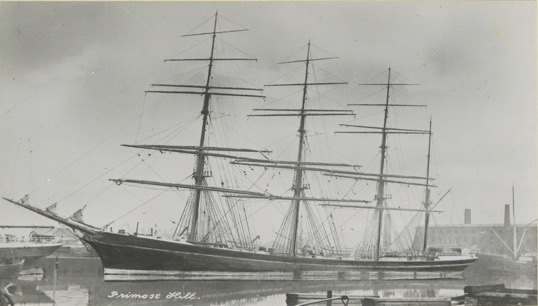Primrose Hill

The build
The Primrose Hill, a four-masted barque, was built in 1886 by Thomas Royden & Sons with a grt of 2,332. It was constructed mostly of iron and intended for use as a merchant vessel carrying various types of cargo, from coal to aircraft materials.
On its final voyage, the Primrose Hill was staffed with 34 crew members, including twelve apprentices.
The Disaster of 1900
On 23 December 1900, the Primrose Hill set sail to Vancouver from Liverpool. Five days later, the vessel was caught in a storm in the Irish Sea, resulting in the ship losing several of its sails in the gale force winds.
The SS Hibernia, a London & North Western Railway passenger steamer, embarked on a rescue mission. However, the rescue attempts were unsuccessful as the harsh weather conditions prevented a lifeboat being sent out and an attempt to arrest the ship by dropping the anchors also failed.
Then disaster struck. The Primrose Hill broke onto two rocks near the South Stack lighthouse on Anglesey in North Wales. Eyewitnesses reported that the vessel disappeared within 15 minutes.
Out of the 34-man crew, there was only one survivor: Johan Pettersen, a Swedish able seaman who survived by clinging onto the poop rail. When the ship struck the rocks, he was swept ashore by a huge wave.
Primrose Hill Fact File
Where was Primrose Hill built?
The Primrose Hill was built in the British city of Liverpool.
How big was the Primrose Hill?
The four-masted barque was 301ft long and 42ft wide, with a tonnage of 2,332 grt.
Where did the Primrose Hill set sail for on its last voyage?
The Primrose Hill was bound for Vancouver, setting sail on 23 December 1900.
How many survivors were there?
There was one survivor, a Swedish seafarer called Johan Pettersen.
Legacy
The loss of the Primrose Hill was incredibly important to debates on improving crewing standards. At this time there was increased pressure on the UK government to ensure that certificated officers were carried on all ships, along with demands to reintroduce rules regulating the nationality of masters and officers which had been previously abolished in 1849. There was also a call to improve the standards of certification.
One of Nautilus International’s predecessor unions, the Merchant Service Guild, was pressed hard for an inquiry into the circumstances of the loss of the Primrose Hill, which would also investigate concerns about the crewing of the vessel.
The Guild made a formal complaint to the Home Secretary when the union's solicitor, who was representing the relatives of the crew members who were lost with the ship, was refused a hearing at the inquiry.
The major concerns were around the level of experience of those onboard, with five of the apprentices having never been to sea before. Only the master and mate were certificated seafarers.
However, the inquiry heard that problems around crewing were common in Liverpool. Despite acknowledging the crew was not adequate for the voyage it was undertaking, the court ruled that there was no evidence that this caused the loss of the ship.
A memorial was constructed at Maeshyfryd Cemetery on Anglesey to commemorate the lives lost that day.
Contribute
Are you knowledgeable about this vessel?
Submit your contribution to this article to our editorial team.
Write to usView more ships of the past
HMS Beagle
Launched 200 years ago, HMS Beagle has been described as one of the most important ships in history – thanks to the observations on evolution and natural selection that its famous passenger Charles Darwin made during a five-year voyage around the world between 1831 and 1836.
Common.ReadMoreHMS Beagle
Oxfordshire
The Oxfordshire had a 34-year long career as an emigrant ship, passenger liner and cruiseship.
Common.ReadMoreOxfordshire
Ruahine
Entering into service just over 70 years ago, the Ruahine was the last passenger-carrying ship built for the New Zealand Shipping Company (NZSC), and the third to bear the name – which means 'wise woman' in Māori.
Common.ReadMore